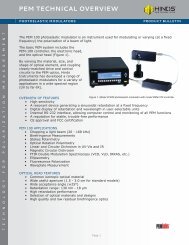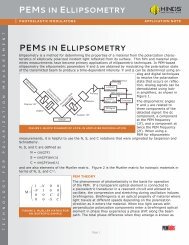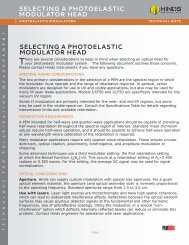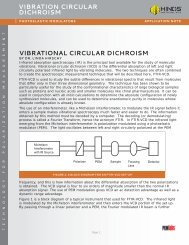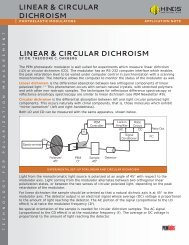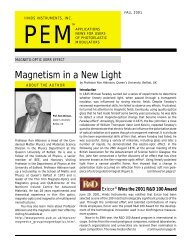A PEM-based Stokes Polarimeter for Tokamak ... - Hinds Instruments
A PEM-based Stokes Polarimeter for Tokamak ... - Hinds Instruments
A PEM-based Stokes Polarimeter for Tokamak ... - Hinds Instruments
You also want an ePaper? Increase the reach of your titles
YUMPU automatically turns print PDFs into web optimized ePapers that Google loves.
Novel system design detailsThere are a number of unique design features associatedwith this and other tokamak <strong>PEM</strong> polarimeter systems.1 Protecting the <strong>PEM</strong> electronic heads from strongmagnetic fields.The <strong>PEM</strong> electronic heads are susceptible to strongmagnetic fields. It is there<strong>for</strong>e necessary to locate theelectronic heads some distance away from the dual opticalDhead, or magnetically shield the electronic heads or both.The coaxial head-to-head cables are 15 meters long <strong>for</strong> theASDEX Upgrade tokamak installation.2 Optical signal transmission via optical fibersOptical fiber bundles are used to conduct the lightfrom the <strong>PEM</strong> assembly to the individual detectors(photomultiplier tubes or PMTs). The intensity modulatedlight signals are carried to the control room where thedetectors and associated electronics are located. The polarizationof the light is lost in the fibers, but this is an advantage,since the type of PMTs being used are polarizationsensitive.3 Fine tuning of wavelength selectionAn aspheric lens collimates the light coming from theend of the fiber bundle which passes through an interferencefilter and another lens to the photomultiplier tube. Eachinterference filter has a spectral bandwidth of about 0.2 to0.3 nm. The center wavelength of each filter is “tuned” byvarying the filter temperature and/or tilting the filter. Eachchannel has a single PMT which is connected to a preamplifierwith a gain of 10 volt/amp. Each pre-amplifier is5then connected to two lock-in amplifiers, one at 40 kHz andthe other at 46 kHz (twice the oscillation frequencies of the<strong>PEM</strong>s).4 Real-time data analysisThe output of each lock-in amplifier goes to an A-D converter.Data is sampled at a rate of 1 kHz. At the present,ASDEX Upgrade data is reduced at the end of the run. Itwould be possible to per<strong>for</strong>m real-time data analysis and usethe in<strong>for</strong>mation in a feedback loop to control the reactor.This may be tried with the ASDEX Upgrade in the future.B0 rInsidewalltorusvacuumchamberOutsidewalltoroidalfieldstrengthpoloidalfieldstrengthFigure 4. Relative intensities of toroidal and poloidalmagnetic fields, vs radial position.Summary<strong>Stokes</strong> polarimeters using a dual <strong>PEM</strong> are an important partof the diagnostics of tokamak plasmas in installationsaround the world. <strong>Hinds</strong> <strong>Instruments</strong> employees are proudof the role our product plays in nuclear fusion research. Weat <strong>Hinds</strong> <strong>Instruments</strong> are very grateful to Dr. Fred Levinton ofFusion Physics <strong>for</strong> developing this application of thephotoelastic modulator and <strong>for</strong> his assistance with thisarticle. I am personally grateful to Dr. Robert Wolf <strong>for</strong> hisassistance in helping me understand the operation of thetokamak and the details of the Motional Stark Effectpolarimeter and <strong>for</strong> his assistance in preparing this article.Bibliography1. Herman, Robin, “Fusion: The Search <strong>for</strong> Endless Energy”, CambridgeUniversity Press, 1990.2. F.M. Levinton, et.al., “Magnetic field pitch angle diagnostic using themotional Stark effect”, (invited), Rev. Sci. Instrum. 61 2914 (1990).3. F.M. Levinton, “The multichannel motional Stark effect diagnostic onTFTR,” Rev. Sci. Inst. 63 5157 (1992).4. D. Wroblewski and L.L. Lao, “Polarimetry of motional Stark effect anddetermination of current profiles in DIII-D”, (invited) Rev. Sci. Instrum.63 5140 (1992).5. F.M. Levinton, et.al., “Improved Confinement with Reversed MagneticShear in TFTR”, Phys. Rev. Lett 75 4417 (1995).<strong>Hinds</strong> <strong>Instruments</strong> Teams with InternationalSEMATECH to Develop an Instrument thatCharacterizes Birefringence in Calcium Fluoride<strong>for</strong> 157 nm MicrolithographyIn recent years, optical lithography has continued itstransition to shorter wavelengths in order to produce moreadvanced microchips. The next generation of optical lithographysystems will use F2Excimer lasers operating at157 nm. Due to its unique optical properties and readiness<strong>for</strong> large-scale production, calcium fluoride (CaF 2) is the onlypractical optical material available <strong>for</strong> use in stepper andscanner lenses at this wavelength. Consequently, linear birefringencein CaF2components has emerged as an importantquality parameter <strong>for</strong> the optical lithography industry.In May 2001, as part of a project with InternationalSEMATECH, researchers at the National Institute ofStandards and Technology (NIST) reported intrinsicbirefringence in CaF2that affects lens design and images atthe wafer level in 157 nm microlithography systems. Thisnews came as an unwelcome surprise to the opticallithography industry. Prior to this discovery it was commonlyassumed, incorrectly, that CaF 2, belonging to the cubiccrystal group, was an “isotropic” material.(continued on page 6)C The magnitude of the Doppler shift in wavelength is proportional to the componentof the particle velocity along the direction of the line of sight.D<strong>Hinds</strong> <strong>Instruments</strong> recommends that the electronic heads be located in a magneticfield no stronger than 100 Gauss or 0.01 Tesla.SUMMER 2002 4




